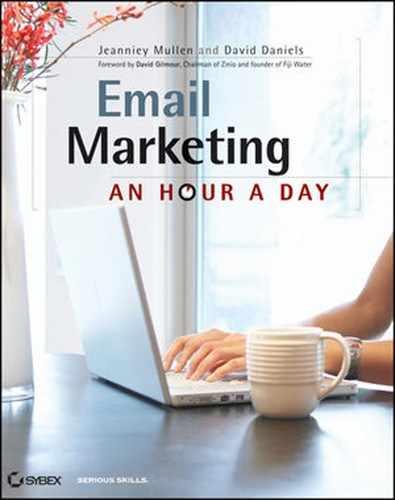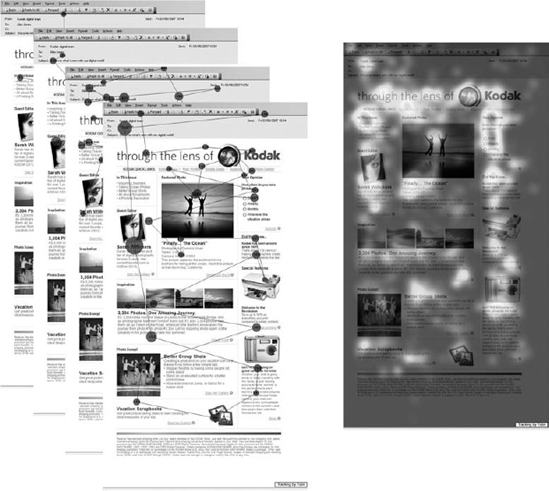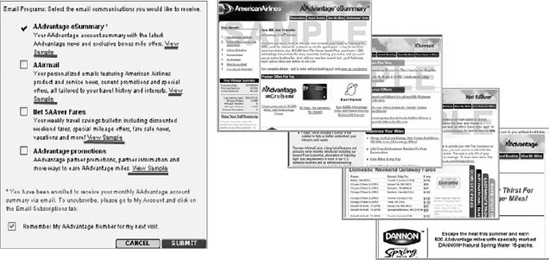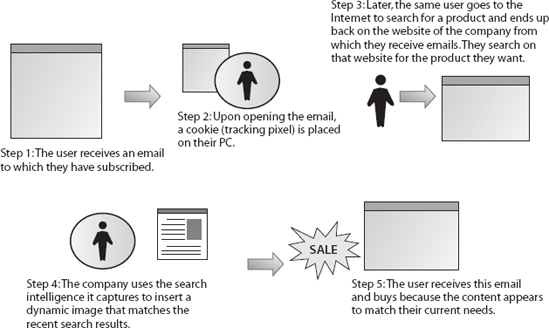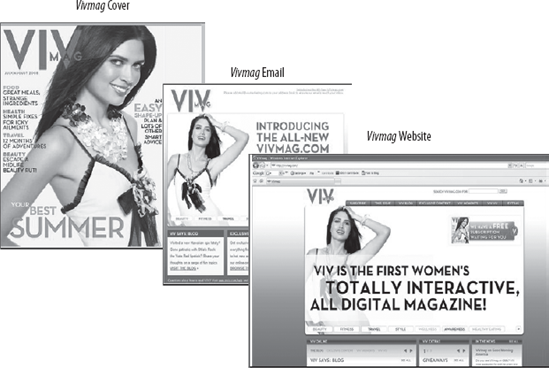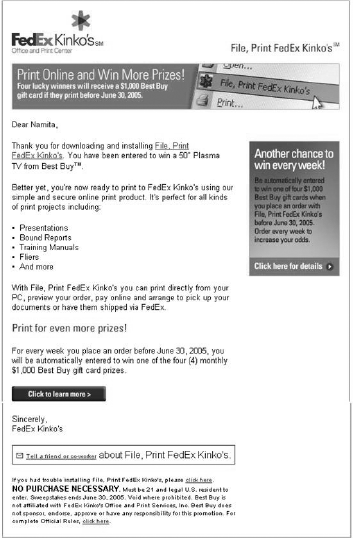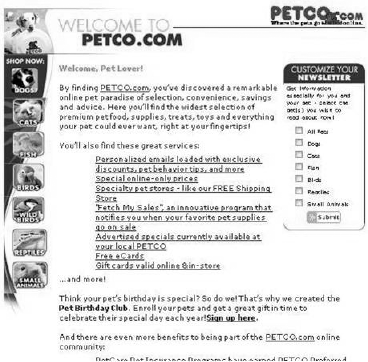In the first chapter, we explored the five categories of email messages you will send: awareness, consideration, conversion, usage, and loyalty. This chapter focuses on the critical elements to consider for any of these types when designing an email campaign. To become a skilled email marketer, you need to understand how to continue improving results over time. This chapter will help, and we hope it quickly becomes one you bookmark for future reference.
Chapter Contents
Creating Brand Impact
Adding Intelligence to Your Design
Driving the Purchase
Creating Transactional/Service Messages
Adding Viral Marketing Elements
How much brand impact does your email create? Regardless of the purpose of your email message, one thing is for sure: your email message is going to have an impact on, and be impacted by, the strength of your company's brand. If this impact is good, your email program will enhance credibility and create a sense of trust with your consumer, which are major components of brand equity. This moves them one step closer to engaging with your organization. If this impact is bad, you could very well have single-handedly ruined the chances your reader will ever do business with your company again.
The example we just shared with you would have occurred long before email even existed. But it is the clearest representation of the power and reach of an existing brand's influence that we can imagine. The brand expectation and influence that is carried into your reader's inbox is no different. At the first sight of a company name or logo, the reader will make a certain set of presumptions about the purpose and strength of the content contained within the email. This is a critical element for every email marketer to remember. Email design will influence your broader brand equity, and your company's brand equity will influence engagement with your email campaigns. You can't separate the two.
Note
Write This Down: Ninety percent of readers will use email to engage in and determine the value of a relationship with a company.
Every email that reaches an inbox will be given some sort of consideration. Typically, a recipient will look at the From name and/or the subject line to determine whether the message is worth opening immediately, later, or not at all. Although many studies have been conducted to attempt to determine whether more attention is given to the From name or the subject line, their results remain inconclusive. Many factors are involved. For example, the devices on which emails are read and the surrounding environment in which emails are read both play roles in determining which of these two critical areas of the email receive attention. That said, determining how much brand equity your emails currently carry is a critically important element of your email marketing success.
It's nearly impossible to determine existing brand equity in a "live" manner; you will need to develop a test. One cost-effective way of determining brand equity is by conducting an eye-tracking test called heatmapping. In this process, a sampling of representative readers is exposed to an email inbox containing multiple messages. The order in which they look at different items in the inbox and the length of time the readers spend looking at each are noted by recording the viewing behavior using eye-tracking machines. The results are aggregated, and a heatmap is created, clearly showing areas of influence. Essentially, heatmapping shows how long people spend looking at your contents to determine whether they are interested in your brand. Although you cannot calculate the level of brand equity you have with them from this, you will find out whether your brand resonates with your viewer—whether it has equity/value.
In the example shown in Figure 2.1, you can see how people process the inbox for a series of emails sent.
Regardless of the types of messages listed in this inbox, the name of the company consistently gets attention. Well-known company names generate strong brand equity for their target sector. If you were looking to increase your skills in a target area and a well-known company in that sector sent you an email, without knowing what it is said inside, wouldn't you give higher consideration to opening it than to an email from an unknown sweepstakes verification company?
The cost of heatmapping services can range anywhere from a few thousand dollars per test to more than $100,000 annually depending on the size of the study, the specialized audience requirements, and the number of tests you want to run. That said, even if you opt for a small study, we can promise you the ROI will be worth it. If you do decide to move forward with heatmapping, we offer you one caution: Although a number of companies claim to provide heatmapping services, you really need to ask what this entails. In this chapter (and throughout the book), we refer to heatmapping as the service provided by companies that actually captures the reflection of viewers' retinal activity as they look at pages online. Some companies will tell you they provide heatmapping services but will do so by aggregating click activity and showing you heatmaps of where people click. Although that information is helpful, it is not what you want.
An effective heatmapping study relies on the results of being able to capture where people look and in what order they see your page elements. Currently, the top two companies providing heatmapping services around the world are Think Eyetracking (www.thinkeyetracking.com) and Eyetools (www.eyetools.com).
Understanding your brand equity prior to designing an email marketing efforts is key. It lets you know how much of a challenge you will face to get your email opened, let alone read. Much of the success of your email marketing efforts depends on getting your emails opened. A company with a low level of brand awareness or equity (aka trust) will have a lower open rate. A big mistake many people new to email marketing make is to think that the offer is the most critical part of your program design. In reality, the most important part of your campaign is going to change based on the level of brand awareness and equity. If no one opens your email because they do not know or trust your brand, your email marketing program cannot succeed.
If your brand equity is low, it's most likely for one of two reasons:
Your company is new and does not have an established brand.
Your brand carries a sense of low value/trust.
New companies have an interesting challenge. They have low brand equity simply because they are not known products. Whether a new company is a new player in an existing field (for example, a new retail store) or a new company introducing a new concept to the world (for example, when ATM cards first came onto the market), it must follow the same strategies as an existing company that has low levels of equity with the consumer base.
The bottom line is, if your brand equity is low, your approach to email must be very different than if it were higher. Since you cannot rely on your email getting strong open rates, you will need to focus on establishing brand equity and a connection when people are opting in to your email programs. In this case, a combination of a preference center and a welcome email is critical. That is, on the web page where someone is about to provide an email address, you should clearly show the options for email types they have and the frequency of those messages; this will help rebuild trust and credibility. Following up with a welcome email that clearly restates the value proposition for agreeing to receive the emails and the expected frequency will also help increase response.
Note
Write This Down: Do not expect strong results where there is low brand equity or awareness.
Travel and leisure retailers seem to be the furthest along in building equity enhancement programs. American Airlines is one of the best in its class when it comes to reinforcing brand equity through its preference center and welcome emails. As you can see in Figure 2.2, the airline follows all the critical best practices.
Once you get beyond the inbox and your email has been opened, your brand equity is still important. Every time a reader opens an email, they have an expectation for content or offers based on prior online and offline brand experiences. Your job at this point is to make them feel like you've read their mind, anticipating exactly what they need. This is a challenge you need to be prepared for when you enter the world of email marketing. How can you be ready?
Creating an effective email requires that you start with a clear understanding of consumer reality. What is consumer reality? It is what the consumer is thinking/expecting when they open your email. It is not what the marketing department, or people who work for your company, assume will happen.
You should keep in mind four basic elements of effective email whenever designing an email marketing strategy:
Don't assume your email recipient has seen your TV, print, or in-store ad. Cute extensions of a TV spot or print ad in an email, without reference to the original ad, can confuse the reader and hurt the brand. Once, a high-tech company running a business-to-business (B2B) campaign had a funny TV spot showing a forklift emptying a roomful of servers to make way for the server of the future. The company followed this with an email showing a photo of the forklift by itself, next to the company logo. When this arrived in the prospects' inboxes, the readers wanted to know whether the company was selling forklifts now.
Your email recipient doesn't read all your emails. Jeanniey once learned this the hard way. The organization she founded, the Email Experience Council (EEC), sends weekly emails. Each week, the staff would slave over creating new content so it would seem fresh and new. Little did they know that the people who receive these emails have lives. Some weeks, the recipients were on vacation and didn't read their EEC email; other weeks they were out sick or working on a big project. In any event, once the EEC staff saw that key messages and offers were receiving low response, they did some testing. The average email recipient needed to receive a key message in three emails in a row in order to actually view the content once; this garnered the highest response. Remembering that your email subscriber doesn't read your emails is a tough reality to swallow, but it pays off in the end.
The copy in your email might not work. This is one of our favorite elements to share with people. Often, you or your copywriters will work hard to ensure that the copy flows well and has a rhythm to it that invigorates your reader. Email copy is poetic, right? Reality check: If the copy you are using in your email does not align with the search phrases people are using when they visit your site, you are missing the significance. For example, when IBM first launched its laptops, it decided to call them ThinkPads. This was a brand name that gave IBM a perceived competitive edge. Much of the marketing referred to the product simply as a "ThinkPad," not as a laptop computer. But outside the IBM walls, when a person was looking for a laptop, either on the Web at large or on the IBM site, they mainly typed in the search word laptop. Since the ThinkPads weren't referred to as laptops, the search results were minimal.
Note
Put a bookmark in the book here, and call the person who has your search engine results. See how closely they align.
The phrases received in your search box on your website, or even through paid search, reflect the phrases that people associate with your brand. Keeping this in mind when you are writing email copy will move the impact of your message up a few notches by creating a synergy between what your reader reads and what they were thinking.
The first time your email is read, it may not be read in the email inbox. With the proliferation of devices people carry with them to enhance their digital lifestyle, there is an increasing chance that your email message will not be first viewed in the email inbox. An RSS notification may be sent to a reader; an SMS alert may be sent to a mobile device; a BlackBerry, iPhone, or other handheld unit may hold the message; or your message may be diverted to a social networking application. Handheld devices process email content much differently than your computer inbox does. This can cause reading and clicking challenges. In addition to the device-specific challenges, consumers who are reading "on the go" often give a different level of attention and focus to their messages. Keeping these elements in mind can be helpful to you.
Note
A 2007 survey by JupiterResearch asked consumers what technologies they had used in the past year for personal communication, instead of email:
Eighteen percent stated social networks.
Twenty-seven percent stated SMS texting.
Currently only 4 percent of email users in the United States subscribe to RSS feeds.
When creating your content, know that size restrictions, the ability to read or interact with messages, and simply the amount of attention given to the content being read "on the run" all play a role in the way the reader digests your email message.
To help you gain an advantage from the insights we have shared so far, we would like to ask you to start thinking about your email campaigns differently. Do not assume that your email message will be viewed by your reader in an inbox setting, where they can give your message full attention. More and more people are reading emails in a mobile environment. Also, you should assume that by the time someone receives an email from you, they have probably already seen or heard about your company through some other media element. Maybe it was your website or an ad banner through a search. Yes, when designing your email effort, begin with the assumption that before your email arrived, your recipient may have been influenced by other media pertaining to that particular product or service, whether online, or via search or mobile. Also assume that once they read your email, they are not going to buy right away and will go to the Web to search for customer reviews, competitive products, and more.
Now, use these assumptions to take your email program up another notch and create an email that resonates with your reader as not just effective but insightful. After you read the next section of the book, you will be able to, so keep reading.
Not only does the recipient have certain expectations about your email just by looking at the From name and subject line, but once they open it, they are reading the content with biases relating to what they may or may have not been exposed to through other marketing and advertising elements your company is running.
That said, you might not even recognize that you hold the key to looking like a rock star in your customer's mind by integrating your email program with your search and display programs. There are two approaches to creating this success: you can start with your in-house file or start with your display ads. Either way is phenomenal. Here is how they work.
To help visualize this process, pretend you are sending an email to recipe enthusiasts:
When someone receives an email from you, drop a non-personally identifiable tracking cookie onto their computer (not the same cookie you use to detect whether an email has been opened).
When this reader goes to your sites search, conducts a web search, or clicks a display ad, you will find out what they are engaging with (for example, fried chicken recipes).
Use this information, including the words they used in the search box and/or the copy on the banner they clicked, to create a dynamic content block in your next house email that offers them access to the content they have been searching for (for example, "New fried chicken recipes now available.")
This process is similar to the previous process, but it begins with the cookie drop on the search landing pages and/or display ads:
When this reader goes to your site search, conducts a web search, or clicks a display ad, you will see what they are engaging with (for example, fried chicken recipes).
When they land on your site and sign up for your emails, what you've learned is passed along and included in the welcome email. You can now speak with certainty in the welcome email to create expectations and offers that appear to have read the new subscriber's mind. (For example, "Thanks for signing up for our recipe emails! We hope you are a fried chicken fan, because that is our feature recipe this month.")
Figure 2.3 illustrates the workflow for both scenarios. Based on proprietary research the authors have conducted in this area, companies that use this type of strategy are seeing results increase more than 300 percent compared to less targeted content strategies.
The content in the email isn't enough. Intelligent emails will go a long way toward making your reader feel as though they truly have a relationship with your brand and your company, but by themselves they are nowhere near enough to make your email marketing program successful.
An interesting phenomenon is taking place in the world of email these days. As an email marketer, you need to not only be aware of it but also learn how to master it. We have finally hit the point where the volume of emails in our personal and business lives has surpassed our ability to digest the content with any high level of comprehension.
Note
Write This Down: JupiterResearch reports that 26 percent of the emails consumers receive in their primary personal inboxes are marketing messages that they opted in to receive.
JupiterResearch says the average person receives 41 emails a day in their inbox. We are going out on a limb to say that anyone in the email marketing field probably receives three times that number (on a good day). Email readers are now challenged with going through their emails as quickly as they can, whenever and wherever they can, just to keep up with the deluge.
Sadly, the effect of this barrage of email content is that it's much more difficult to conduct a quality conversation with your reader. This phenomenon is often referred to as email ADD, as in "email attention deficit disorder." It is estimated that for every three words you type in an email, only one is read or retained. This is a scary reality for consumer marketing emails, and it's even scarier in the business world.
In our digitized world, email ADD is not going to get better. Gaining an understanding of the implications of email ADD is only the starting point. Knowing how to work within constraints to define effective and successful messages is the only way to gain control of the conversation back.
Here are three important techniques:
Always put new content in context before the user hits Delete. If your email reader has no context for the message they are reading, your message equity is at risk. In other words, if you send an email to Joe with fresh content and no mental notes for him to refer to (reminders of prior conversations, links, and so on) and Joe scrolls through the email on his BlackBerry while boarding a train to D.C., your message equity has dropped to 33 percent or less.
Conversely, if your message has associated notes (content callouts, links, or other information), you stand a much higher chance of having your message resonate and be responded to.
Define the email's benefits in terms of the reader's long-term goals. If your email does not clearly and concisely state why the message will help the reader achieve their long-term goals and fulfill future needs, it is at high risk for low comprehension. Good examples might be, "Get access when you need it" or "Save this message for when you need to . . . "
Creating language that is clear and concise and that conveys how your reader will benefit in the long run will pay off many times.
Leverage attention nodes. An attention node is some type of formatting in the email that clearly grabs the reader's attention. In marketing messages, this is most commonly done with a callout box, action tag/button, or other imagery. In a text for personal email, attention nodes can be any creative use of spacing or character keys that help clearly drive where the attention needs to be placed. For example, you can use three asterisks (***) to signify importance. Generally, we are lucky if more than the content in the attention node is read.
Combine these efforts by also leveraging the power of three, and you will succeed. Based on proprietary testing we've done over the past ten years, three is the optimal number of times you should put a message in front of your readers to maximize clicks. Three is also the number of emails a new subscriber will read to determine whether they will stay engaged with your brand's email program. And finally, three is the average number of email subscriptions a reader opts in to for a given category.
Acknowledging that every email (personal or business-related) will need to not only battle reputation, relevance, and delivery but now also email ADD, and understanding how to leverage the power of three to help you do that, can move you three steps ahead in creating a successful conversation.
Once you master the ways you can battle into and then within the inbox and have your message read, you still are only halfway to success. The key to a completely optimized email program is to remember that the main purpose of your email is to drive action at another location—a physical location, a virtual location, or even a location someone visualizes in their mind.
In any event, you need to remember a critical element here: The branding and content in your emails must match the same type of branding and content on the final destination pages. The entire user experience needs to be consistent in order to maintain interest and action.
Figure 2.4 shows an email from the cable service Optimum that demonstrates how doing it out of context can turn a great email into a poor driver of performance. The creative content of this email is strong; it has a clear message and purpose. However, when you click the link, you become lost in the landing page, which has ten links and a different logo, which makes you feel like you've landed in an entirely new and unrelated location.

Figure 2.4. This email (top) promotes a sweepstakes, which links to a rewards microsite (bottom) with a different logo and nine other choices that could distract the reader.
In some cases, these types of inconsistent user paths have generated up to an 80 percent loss in sales. Abandonment is high when your reader isn't guided in a simple and consistent manner. The right way to guarantee success is to maintain consistency between images and copy. And above all, remember that your email creative has to match the creative and messaging of your broader brand. This is the link that holds strong as people leave your email and move into your website or retail store.
In some cases, this can be difficult to do. Figure 2.5 shows an example of a high-end women's digital e-magazine that does a phenomenal job of driving from one location to another and back again.
The take-away from this section is that compelling content alone isn't going to maintain success in your email program, even if it is combined with intelligence and targeting. Using imagery that maintains, manages, and boosts the brand imagery of your email experience is crucial.
If you had a wise old marketing mentor, one thing they probably told you was, "Hit them while their credit card is still out." Although the clear and consistent combination of intelligence, copy, and creative are critical for most email messages, one type of email message allows you to stray, just a bit, from the harsh standards of strategic, creative, and tactical design. This email is the transactional, or service-based, email.
Transactional/service-based emails are not used primarily for marketing purposes. Their purpose is to inform or confirm the reader that an action they have taken has actually happened. The intent of these messages has always been more in line with the types of messages you receive from a customer service division of a company than a marketing division. To maintain this distinction and make sure the content inside these emails remains focused on service intent, the federal government enacted the CAN-SPAM Act of 2003. This law, which took effect January 1, 2004, and was amended effective July 7, 2008, is discussed in detail in Chapter 5, but we can summarize its most important requirements here:
The CAN-SPAM Act requires that businesses do the following:
Clearly label commercial email as advertising
Use a truthful and relevant subject line
Use a legitimate return email address
Provide a valid physical address
Provide a working opt-out option
Process opt-out requests within 10 business days
Although the intent of these emails may have been service-oriented, many crafty marketers use these emails to drive cross-sell or up-sell purchases. Why? It's because, in the reader's mind, these messages confirm an action or purchase recently made. Therefore, they are read faster and at much higher rates than marketing messages. In some cases, these emails are read to confirm that the purchase activity just conducted was recorded appropriately. Could you imagine not opening the email from your favorite airline confirming your purchase of a ticket to Hawaii, only to find out when you arrive at the airport that your ticket is to Newark? Federak Express seems to have figured out how to manage the fine line between marketing emails and transactional emails. In Figure 2.6, you can see an example of a transactional message that also showcases other ways you can work with Federal Express without crossing the line and making it appear that the main purpose of the email is to sell you additional products and services.
Note
Write This Down: Seventy percent of transactional emails are opened and read within three hours of receipt.
Transactional emails may not be the most beautiful emails, but they do seem to garner the highest level of attention from readers. Combine that with the legal requirements to keep the content focused and to the point, and these messages can be quickly viewed and filed or deleted. This helps battle the user's ongoing fight with the inbox email overload that can lead to email ADD.
While transactional messages are typically sent when a purchase is made, one other type of service email is worth mentioning because of the impact it has on your brand equity. This email is called the welcome email.
Like confirmation emails, welcome emails have historically had significantly higher open rates than regular emails. These messages are key to setting expectations with new subscribers and communicating the brand promise. Yet 28 percent of major online retailers still don't send welcome emails. In late 2007, the Email Experience Council conducted a study of welcome emails sent by 122 major retailers. Here are some key findings from the study:
Thirty-two percent of welcome emails included a discount, reward, or incentive.
Sixty-two percent of welcome emails asked the subscriber to whitelist them by adding an email address to their address book.
Seventy-nine percent of retailers sent HTML welcome emails. The remainder sent text-only welcome emails. That said, most of the HTML welcome emails were "HTML lite," making extensive use of HTML text to ensure that the content could be read even when the recipient has blocked images in their inbox.
Fifty-three percent of welcome emails included links to the retailer's privacy policy.
Seventy-five percent of the welcome emails included the retailer's brand name in their subject lines.
Welcome emails hit a reader right after they have raised their hand to let you know they want to engage in a dialogue with you. They are critically important to establishing a profitable relationship with your company. Not only that, but welcome emails and purchase-confirmation transactional emails can also play another key role; they can help turn a reader into an advocate by instigating viral email activity.
In Figure 2.7 you can see a sample welcome email from Petco.com that manages to cover each of these key elements. After receiving this email, you may want to provide additional information about yourself, as well as send this to a fellow pet lover.
A few years ago, one of us was in a meeting with about six clients from the same company. The discussion was about the recommendation to send viral emails. After a few minutes into the overview, a senior client stopped the conversation and said, "I absolutely do not want to send viruses to our customers." It was at that point that the rest of us realized we were all speaking using "inside business" terms. Since that time, the term viral when pertaining to marketing efforts has become fairly mainstream. If you are not familiar with it, we can assure you it is not a bad thing. A viral email, or viral effort, means it is something that resonates so effectively with readers that they share it with many others quickly, something like the way a virus spreads.
The true value of including viral elements in your existing email programs has been a hot topic of debate for a few years now. Advocates of viral email remain solid in their belief that an appealing email, sent to a reader who has a high opinion of your company, can and will be sent to at least five members of that reader's social group. In many cases, these readers are the key stakeholders and influencers your brand desperately wants to reach out to in order to build a relationship and eventually make a sale.
Naysayers of viral email believe it simply doesn't have an impact on future sales at a level of any significance. This group believes the efforts can't be tracked because many people would rather use their Forward button in their email client instead of a form inside an email. Sadly, for email marketers, technology has not developed to a point where elements outside the email content can be tracked and reported on. Although some companies, such as Iconix, are developing ways to enable marketers to track what happens to emails once they reach the inbox, most people are not able to know whether an email marketing message is deleted, forwarded, or filed.
This group also believes that the only effective type of viral marketing is non-sales-related. They think people will forward funny emails or emails with no sales or marketing included.
We're in the first group. We believe that, if used correctly and offered at appropriate times in the relationship, viral elements will drive concrete responses, and therefore they deserve to be recognized as one of the key influencers of your email programs.
Here are some statistics that may help convince you:
According to management consulting firm McKinsey, about two-thirds of all economic activity in the United States is influenced by shared opinions about a product, brand, or service.
According to KnowledgeStorm, just more than half of B2B buyers researching IT solutions cite word of mouth as an important decision-making source, and almost 40 percent specifically cite online forms and communities.
Influential people (meaning those people in your life whose opinions you value significantly) are particularly likely to be sought out for computer purchasing decisions (34 percent vs. 16 percent of the general population).
About half of all online marketers are involved in some form of word-of-mouth or viral activity. In fact, many Fortune 500 marketers like those at Coca-Cola have been quoted as saying that viral marketing efforts allow them to connect with their targets in ways that would never be approved for "traditional" venues.
As you create any email marketing strategy (and later chapters of this book will get into more detail on this), you will always be looking for a way to justify your efforts. With viral marketing, the thing to remember is that you can leverage two types of success. There is no easy or uniform way to measure the influence of word-of-mouth marketing; you should try both quantitative and qualitative measures. The first type measures clicks and pass-alongs; the second type measures community buzz.
Monitor the activity of all pass-along materials including emails, videos, and other viral content. (As discussed further in Chapter 8, you can track an embedded Forward to a Friend link, but that is of limited value because so many people use the email client's own Forward button, an action that can't be tracked.)
Track pass-along rates, click-throughs, open rates, registrations, and downloads.
For registered users, track their engagement levels with each piece of content. This information can be ported back to a central data repository in order to qualify customers and enact business rules for appropriate follow-up communications.
Although it's not email-focused, this often works as a multichannel approach: Employ technology that scours open community platforms such as blogs, chats, message boards, email lists, and newsgroups to capture valuable consumer data in which consumers are communicating their experiences, opinions, and beliefs—positive and negative—about brands and their associated products and services.
By analyzing this data, estimate the general buzz around a product or campaign as an indicator of its word-of-mouth success.
When you're looking to create phenomenal results in your email marketing programs, start with the end in mind. Is your campaign meant to drive interest in your company or product at a high level, or does it need to drive hard-core sales or registrations? Once you have an ultimate goal in mind, you can begin to create the way that your viral efforts will integrate with your current messaging strategy. Adding viral elements does not always require a stand-alone email. Many successful email marketers have found that their best viral successes are created when the viral "ask" is just one element of a larger email. For example, a transactional email might say, "Thanks for your recent purchase. If you tell five friends about this site, we will give you free shipping on your next order."
To help make you as effective at creating wildly successful emails as early on in this book as possible, we thought it would be best to end this chapter with seven best practices tips from the Word of Mouth Marketing Association (WOMMA), which does nothing but focus on viral marketing efforts. Be sure to read the rest of the book, though; we have more great content, tips, and tricks coming up. When you're done, tell your friends and colleagues how helpful it is.
WOMMA offers these tips for developing effective viral efforts:
Take off your corporate-marketing-speak hat. Speak in customer language. Refrain from the usual practice of carefully crafted copy that will immediately be identified as such and ignored. Think of how you would talk to a friend or family member versus an "end user" to whom you are marketing. Even more important than speaking directly is speaking honestly. Be up-front, or you'll create mistrust and potentially damage your brand.
Identify opinion leaders and make friends with them. For every category, there are people who have expertise and are influential in sharing their knowledge with others. These people have a wide circle of influence and can efficiently spread your word to huge numbers of interested parties. Find these influentials, and arm them with relevant information about your product or service.
Make it easy to spread the word. Do whatever possible to facilitate the diffusion of your message. From email, instant messaging, and Forward to a Friend buttons to text messages and events, employ tools that remove all barriers to facilitating dialogue.
Start with the Big Idea. Don't make the mistake of starting tactically, as in "We need an email viral campaign" or "What kind of video can we create that will get passed around?" Concentrate instead on your core marketing objectives, and focus on coming up with the Big Idea or core strategy that will resonate with your target. The best ideas are often the simplest and ideally incorporate a key piece of insight about the consumer.
Connect to your overall marketing strategy. Viral and word-of-mouth efforts can do wonders on their own, but they're far more effective (and you'll get greater efficiency) if they're tied to other elements in your marketing campaign.
Be responsive to the two-way dialogue. Because viral marketing is often "uncharted territory" for marketers, we can forget that we have a responsibility to listen and respond to consumers on their own terms. This means you are no longer responsible just for the messages you deliver but also for listening and appropriately responding to the messages from thousands of customers and prospects.
Measure it all: the good, the bad, and the ugly. In all cases, consumers will tell you what they're thinking. In fact, this is one of the primary reasons many marketers struggle with the idea of viral marketing in the first place. Every program must be carefully monitored to not only register the impact of a program but also to appropriately establish an effective two-way dialogue. From specific clicks to community discussion, effective measurement can make the difference in how useful your program becomes and the depth of impact it provides to your company.
There's a ton of information in this chapter that will be important for you to know. A score of 5 out of 5 will ensure you are on your way to email marketing success.
How many reasons can there be for a low brand equity score?
Does heatmapping work from clicks or eye movement?
What are two key roles that the welcome email plays?
What year was CAN-SPAM first introduced?
Do viral or word-of-mouth email efforts take place only inside the email using the Forward to a Friend link?
